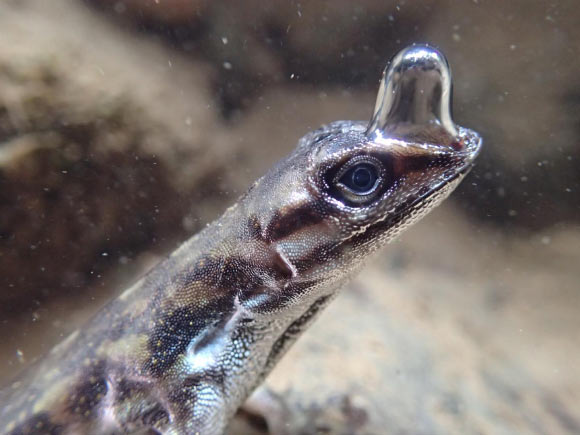Semi-Aquatic Anole Lizards Use Special Bubble Over Their Nostrils to Breathe Underwater: Study

Bubble use evolved in many small invertebrates to enable underwater breathing, but, until recently, there has been no evidence that vertebrate animals use bubbles in a similar manner. Only one group of vertebrates, semi-aquatic Anolis lizards, may be an exception: these lizards dive underwater when threatened and, while underwater, rebreathe a bubble of air over their nostrils. In new research, Binghamton University scientist Lindsey Swierk demonstrated that such rebreathing serves to extend dive time in a semi-aquatic anole, Anolis aquaticus.
Dr. Swerk studies water anoles, a type of semi-aquatic lizard found in the tropical forests of southern Costa Rica.
In 2021, she documented the anoles using a bubble underwater. When these lizards feel threatened by a predator, they dive underwater and breathe a bubble over their heads.
“We know that they can stay underwater for a really long time. We also know that they’re pulling oxygen from this bubble of air,” Dr. Swierk said.
“We didn’t know whether there was actually any functional role for this bubble in respiration.”
“Is it something that lizards do that is just a side effect of their skin’s properties or a respiratory reflex, or is this bubble actually allowing them to stay underwater longer than they would, say, without a bubble?”
To investigate whether the bubble serves a functional role in respiration or is merely a byproduct, Dr. Swierk applied a substance to the lizards’ skin surface that would prevent bubble formation.
“Lizard skin is hydrophobic. Typically, that allows air to stick very tightly to the skin and permits this bubble to form,” Dr. Swierk said.
“But when you cover the skin with an emollient, air no longer sticks to the skin surface, so the bubbles can’t form.”

Semi-aquatic anoles live along Neotropical streams and frequently dive for refuge, remaining underwater for up to 16 minutes. Image credit: Lindsey Swierk.
Dr. Swierk recorded the number of bubbles that the lizards could produce and how long they could stay underwater, and compared them to lizards in a control group that were allowed to breathe normally.
She found that the lizards in the control group could stay underwater 32% longer than those with impaired bubble formation.
“This is really significant because this is the first experiment that truly shows adaptive significance of bubbles. Rebreathing bubbles allow lizards to stay underwater longer. Before, we suspected it — we saw a pattern — but we didn’t actually test if it served a functional role,” Dr. Swierk said.
She confirmed that the bubble helps lizards stay underwater for longer periods, providing them with a refuge from predators.
“Anoles are kind of like the chicken nuggets of the forest. Birds eat them, snakes eat them,” Dr. Swiek said.
“So by jumping in the water, they can escape a lot of their predators, and they remain very still underwater.”
“They’re pretty well camouflaged underwater as well, and they just stay underwater until that danger passes.”
“We know that they can stay underwater at least about 20 minutes, but probably longer.”
The paper will appear this week in the journal Biology Letters.
_____
L. Swierk. 2024. Novel rebreathing adaptation extends dive time in a semi-aquatic lizard. Biol. Lett 20: 20240371; doi: 10.1098/rsbl.2024.0371
 Print
Print


